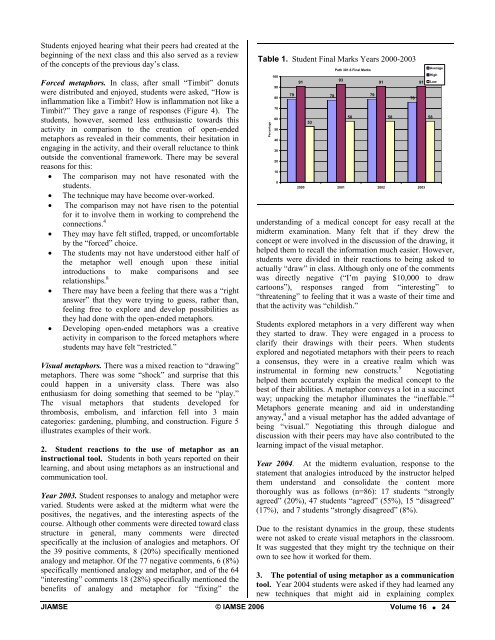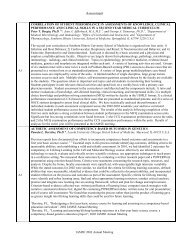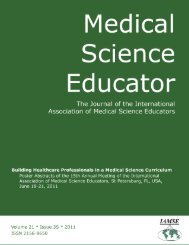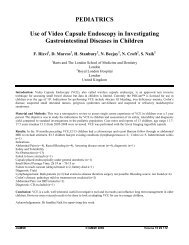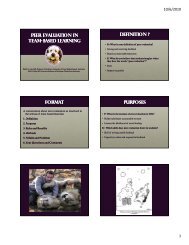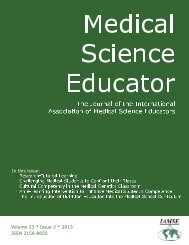Using Metaphors, Analogies and Similes as Aids in ... - IAMSE
Using Metaphors, Analogies and Similes as Aids in ... - IAMSE
Using Metaphors, Analogies and Similes as Aids in ... - IAMSE
Create successful ePaper yourself
Turn your PDF publications into a flip-book with our unique Google optimized e-Paper software.
Students enjoyed hear<strong>in</strong>g what their peers had created at thebeg<strong>in</strong>n<strong>in</strong>g of the next cl<strong>as</strong>s <strong>and</strong> this also served <strong>as</strong> a reviewof the concepts of the previous day’s cl<strong>as</strong>s.Forced metaphors. In cl<strong>as</strong>s, after small “Timbit” donutswere distributed <strong>and</strong> enjoyed, students were <strong>as</strong>ked, “How is<strong>in</strong>flammation like a Timbit? How is <strong>in</strong>flammation not like aTimbit?” They gave a range of responses (Figure 4). Thestudents, however, seemed less enthusi<strong>as</strong>tic towards thisactivity <strong>in</strong> comparison to the creation of open-endedmetaphors <strong>as</strong> revealed <strong>in</strong> their comments, their hesitation <strong>in</strong>engag<strong>in</strong>g <strong>in</strong> the activity, <strong>and</strong> their overall reluctance to th<strong>in</strong>koutside the conventional framework. There may be severalre<strong>as</strong>ons for this:• The comparison may not have resonated with thestudents.• The technique may have become over-worked.• The comparison may not have risen to the potentialfor it to <strong>in</strong>volve them <strong>in</strong> work<strong>in</strong>g to comprehend theconnections. 4• They may have felt stifled, trapped, or uncomfortableby the “forced” choice.• The students may not have understood either half ofthe metaphor well enough upon these <strong>in</strong>itial<strong>in</strong>troductions to make comparisons <strong>and</strong> seerelationships. 8• There may have been a feel<strong>in</strong>g that there w<strong>as</strong> a “rightanswer” that they were try<strong>in</strong>g to guess, rather than,feel<strong>in</strong>g free to explore <strong>and</strong> develop possibilities <strong>as</strong>they had done with the open-ended metaphors.• Develop<strong>in</strong>g open-ended metaphors w<strong>as</strong> a creativeactivity <strong>in</strong> comparison to the forced metaphors wherestudents may have felt “restricted.”Visual metaphors. There w<strong>as</strong> a mixed reaction to “draw<strong>in</strong>g”metaphors. There w<strong>as</strong> some “shock” <strong>and</strong> surprise that thiscould happen <strong>in</strong> a university cl<strong>as</strong>s. There w<strong>as</strong> alsoenthusi<strong>as</strong>m for do<strong>in</strong>g someth<strong>in</strong>g that seemed to be “play.”The visual metaphors that students developed forthrombosis, embolism, <strong>and</strong> <strong>in</strong>farction fell <strong>in</strong>to 3 ma<strong>in</strong>categories: garden<strong>in</strong>g, plumb<strong>in</strong>g, <strong>and</strong> construction. Figure 5illustrates examples of their work.2. Student reactions to the use of metaphor <strong>as</strong> an<strong>in</strong>structional tool. Students <strong>in</strong> both years reported on theirlearn<strong>in</strong>g, <strong>and</strong> about us<strong>in</strong>g metaphors <strong>as</strong> an <strong>in</strong>structional <strong>and</strong>communication tool.Year 2003. Student responses to analogy <strong>and</strong> metaphor werevaried. Students were <strong>as</strong>ked at the midterm what were thepositives, the negatives, <strong>and</strong> the <strong>in</strong>terest<strong>in</strong>g <strong>as</strong>pects of thecourse. Although other comments were directed toward cl<strong>as</strong>sstructure <strong>in</strong> general, many comments were directedspecifically at the <strong>in</strong>clusion of analogies <strong>and</strong> metaphors. Ofthe 39 positive comments, 8 (20%) specifically mentionedanalogy <strong>and</strong> metaphor. Of the 77 negative comments, 6 (8%)specifically mentioned analogy <strong>and</strong> metaphor, <strong>and</strong> of the 64“<strong>in</strong>terest<strong>in</strong>g” comments 18 (28%) specifically mentioned thebenefits of analogy <strong>and</strong> metaphor for “fix<strong>in</strong>g” theTable 1. Student F<strong>in</strong>al Marks Years 2000-2003Path 301.6 F<strong>in</strong>al Marks79 78 79underst<strong>and</strong><strong>in</strong>g of a medical concept for e<strong>as</strong>y recall at themidterm exam<strong>in</strong>ation. Many felt that if they drew theconcept or were <strong>in</strong>volved <strong>in</strong> the discussion of the draw<strong>in</strong>g, ithelped them to recall the <strong>in</strong>formation much e<strong>as</strong>ier. However,students were divided <strong>in</strong> their reactions to be<strong>in</strong>g <strong>as</strong>ked toactually “draw” <strong>in</strong> cl<strong>as</strong>s. Although only one of the commentsw<strong>as</strong> directly negative (“I’m pay<strong>in</strong>g $10,000 to drawcartoons”), responses ranged from “<strong>in</strong>terest<strong>in</strong>g” to“threaten<strong>in</strong>g” to feel<strong>in</strong>g that it w<strong>as</strong> a w<strong>as</strong>te of their time <strong>and</strong>that the activity w<strong>as</strong> “childish.”Students explored metaphors <strong>in</strong> a very different way whenthey started to draw. They were engaged <strong>in</strong> a process toclarify their draw<strong>in</strong>gs with their peers. When studentsexplored <strong>and</strong> negotiated metaphors with their peers to reacha consensus, they were <strong>in</strong> a creative realm which w<strong>as</strong><strong>in</strong>strumental <strong>in</strong> form<strong>in</strong>g new constructs. 9 Negotiat<strong>in</strong>ghelped them accurately expla<strong>in</strong> the medical concept to thebest of their abilities. A metaphor conveys a lot <strong>in</strong> a succ<strong>in</strong>ctway; unpack<strong>in</strong>g the metaphor illum<strong>in</strong>ates the “<strong>in</strong>effable.” 4<strong>Metaphors</strong> generate mean<strong>in</strong>g <strong>and</strong> aid <strong>in</strong> underst<strong>and</strong><strong>in</strong>ganyway, 4 <strong>and</strong> a visual metaphor h<strong>as</strong> the added advantage ofbe<strong>in</strong>g “visual.” Negotiat<strong>in</strong>g this through dialogue <strong>and</strong>discussion with their peers may have also contributed to thelearn<strong>in</strong>g impact of the visual metaphor.Year 2004. At the midterm evaluation, response to thestatement that analogies <strong>in</strong>troduced by the <strong>in</strong>structor helpedthem underst<strong>and</strong> <strong>and</strong> consolidate the content morethoroughly w<strong>as</strong> <strong>as</strong> follows (n=86): 17 students “stronglyagreed” (20%), 47 students “agreed” (55%), 15 “disagreed”(17%), <strong>and</strong> 7 students “strongly disagreed” (8%).Due to the resistant dynamics <strong>in</strong> the group, these studentswere not <strong>as</strong>ked to create visual metaphors <strong>in</strong> the cl<strong>as</strong>sroom.It w<strong>as</strong> suggested that they might try the technique on theirown to see how it worked for them.3. The potential of us<strong>in</strong>g metaphor <strong>as</strong> a communicationtool. Year 2004 students were <strong>as</strong>ked if they had learned anynew techniques that might aid <strong>in</strong> expla<strong>in</strong><strong>in</strong>g complexJ<strong>IAMSE</strong> © <strong>IAMSE</strong> 2006 Volume 16 24Percentage100908070605040302010091539391 917658 58 582000 2001 2002 2003AverageHighLow


